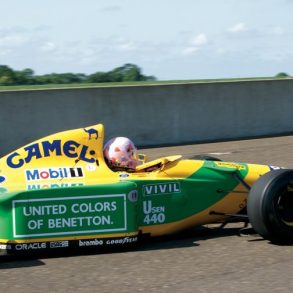John Surtees Biography
The eldest of three children, John was born on February 11, 1934 in Tatsfield, England. His father Jack, who owned a motorcycle shop on Tamworth Road in Croydon, South London was a three-time British motorcycle sidecar champion so it’s not surprising that by the time he was 11 he had a bike of his own and could ride and repair it with equal skill.

At 16 he had left school and became an apprentice engineer at the Vincent motorcycle factory. His first road race was on a pre-war Triumph 250 at the, Brands Hatch in 1950. Just as it began to rain Surtees took the lead going into Paddock Bend, and promptly fell off. Later at the Aberdare Park circuit in South Wales, he scored his first win. Surtees would later comment that, “Of all the races I did in my life, that was probably the one that had the most effect on me. For the first time I was no longer just a mechanic who rode a bike. The bike and I became one. We spoke to each other, we were exchanging messages through the seat of my pants. I realized that’s what you need to get the best from a piece of machinery. It shaped the mould for the rest of my racing career.” Surtees made headlines in 1951 when he gave Norton star Geoff Duke who was known as the “Iron Duke” a strong challenge in an ACU race at the Thruxton Circuit, something that Norton race chief Joe Craig would remember four years later when he gave the 20-year old a sponsored ride with the famous British team.

“In fact I only got involved with cars by accident. It had been suggested to me before, but I always considered myself a motorbike rider. But then MV Augusta restricted my bike programme – I wasn’t allowed to ride my own bikes on the British circuits because the Italian media said it was me winning, not MV. I thought there was nothing to stop me from doing some car races, and in fact my first race came about through being introduced to Ken Tyrrell, who promptly told me he had already entered me for Goodwood and spoken to the RAC about my licence. What did I have to say? ‘Why not!’ recalled Surtees in a later interview.
He would set pole and finish a strong second to Jim Clark in the 1960 F3 race. Clark was then a promising beginner with Team Lotus, whose boss Colin Chapman promptly hired Surtees for the last four races of the 1960 Formula One season.
His results – a second place in the British Grand Prix where he finished ahead of his teammate Innes Ireland and just behind Jack Brabham. A pole position in qualifying and near win in Portugal – made Surtees a driver in demand. Surtees found that he had a better time of it in the fast corners than the slow ones finding the technique at least in fast corners for two wheels more closely followed that of four. He stopped racing motorcycles and considered several Formula One offers, including one from Chapman to partner Clark replacing Ireland at Team Lotus with Surtees as number one. Instead, Surtees not wanting to be part of a three into two with Ireland opted to drive a Cooper in 1961 and a Lola in 1962, neither venture producing much in the way of results. However, his twin strengths of talent and tenacity kept Surtees in the limelight, especially in Italy, where the former MV Agusta star was now invited to lead the country’s famous Formula One team.

For John Surtees, the satisfaction of becoming the first World Champion on both two and four wheels was only mitigated by the fact that he had clinched all his bike titles with race victories. Though he would win three more Formula One championship races, there were no more driving titles in his future. To some degree he was a victim of circumstances, though his feisty personality and fierce independence were also factors. He developed a reputation for being argumentative and cantankerous. Certainly, he said what he thought and did not suffer fools gladly. That being said it was this personality that may have saved his life later when working with Honda.


The following two years were spent leading Honda’s new Formula One team. He helped develop the Japanese cars and was rewarded with a satisfying win in Ferrari’s home race, the 1967 Italian Grand Prix at Monza, though Honda left Formula One racing a year later.
After a frustrating 1969 season with BRM, Surtees decided to follow the lead of Jack Brabham and Bruce McLaren and form his own team, though he was destined to have much less success though not for lack of trying. In nine problem plagued Formula One seasons the best results for Team Surtees were a second and a third for Mike Hailwood, himself a multiple world champion on bikes. Surtees had more luck in F5000 after taking over the failed Leda F5000 project, and constructing its own cars, winning five races, consecutively, during a twelve race season, winning the British and American Championships in 1970. Had Surtees concentrated on building cars for the lower formula that were relatively simple and dependable he may have been able to build a nice business.

His return to health gave him a new lease on life and the former curmudgeon has mellowed considerably. He retired to the English countryside, where he developed an interest in architecture and a very successful real estate business redeveloping industrial property. Only then was the one and only champion on two wheels and four able to fully enjoy his singular achievements – of which he said: “I was a bit nuts, really.” Sadly tragedy would strike in 2009 when Surtees’ son Henry was killed at Brands Hatch when hit on the head by a wheel from another car.



















